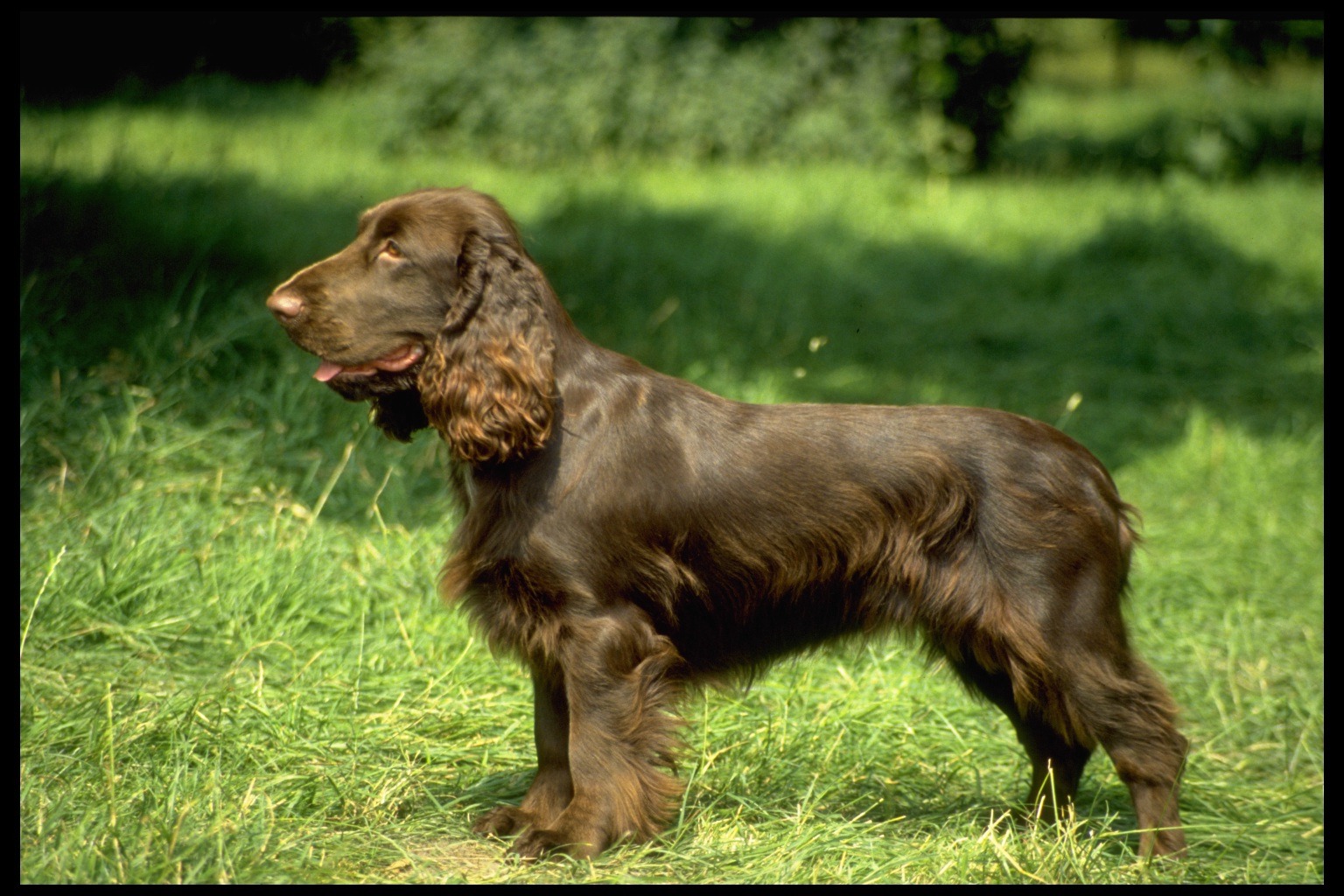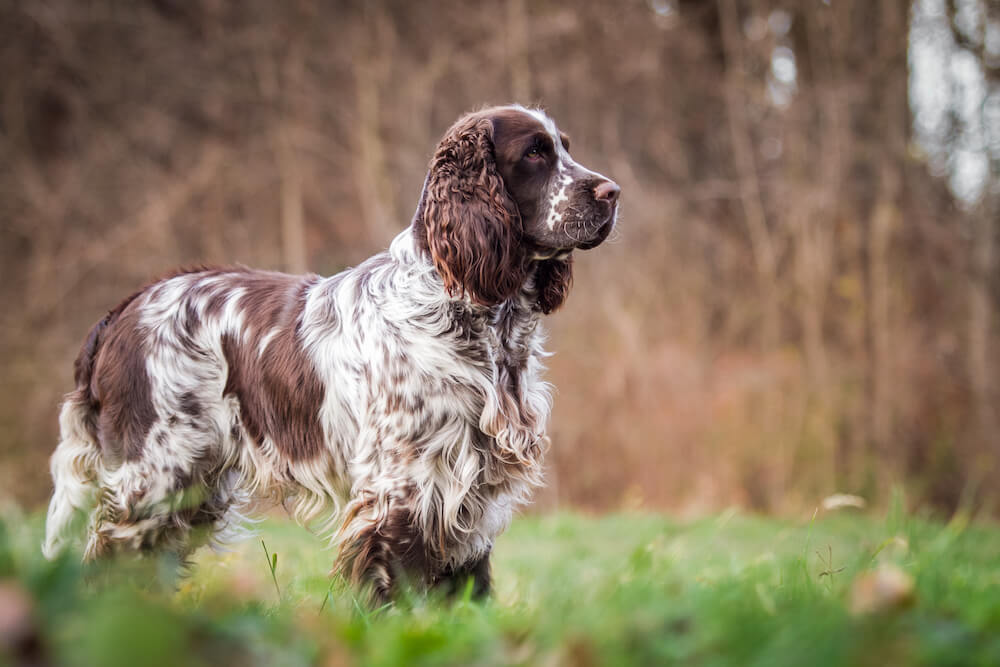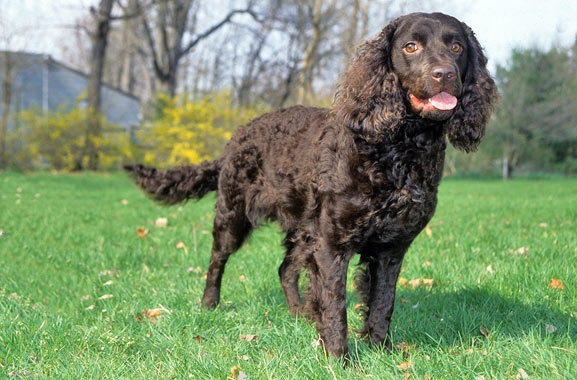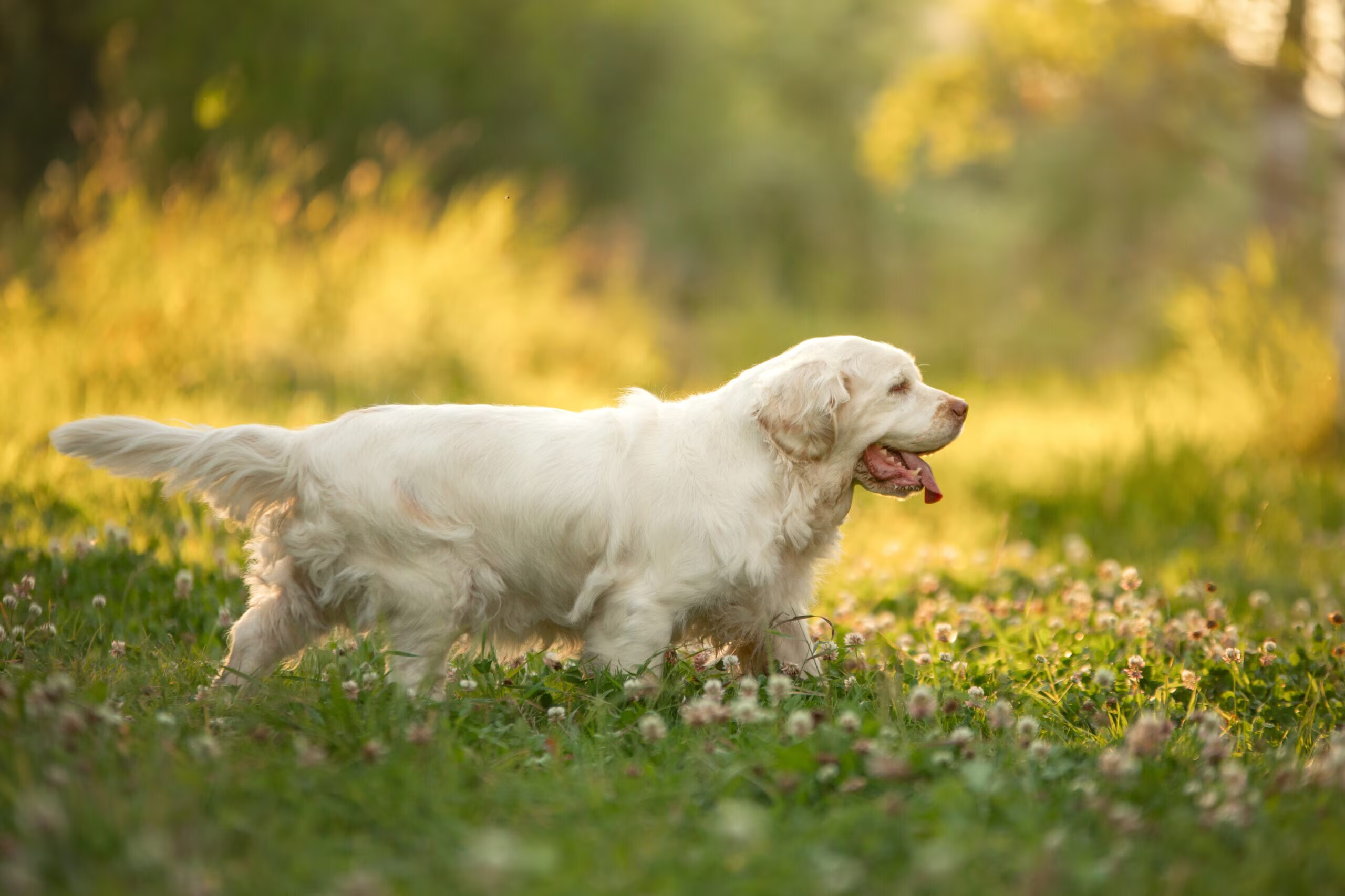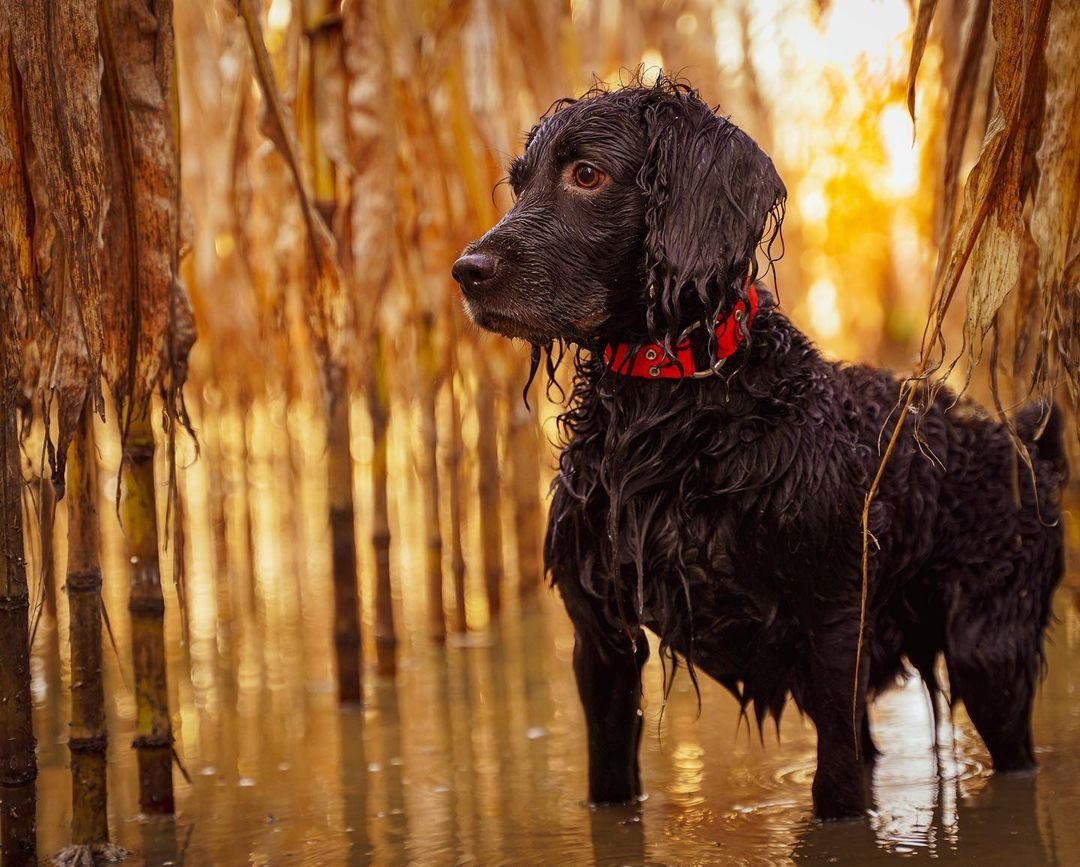The first time I encountered a Field Spaniel at a dog show, I was immediately struck by its dignified presence. With a gorgeous, flowing coat the color of dark chocolate and an expression that somehow managed to be both serious and gentle simultaneously, this dog had a quiet confidence that drew me in. Unlike the more exuberant spaniels bouncing around nearby, this one carried itself with an understated elegance that seemed almost regal. “That’s a Field Spaniel,” the handler told me, noting my obvious curiosity. “Most people haven’t heard of them—they’re pretty rare these days.”
Here at pawtrix.wiki, we love shining a spotlight on lesser-known dog breeds that deserve more recognition, and the Field Spaniel certainly fits that description. As one of the rarest AKC-recognized breeds, these medium-sized sporting dogs combine the best qualities of spaniels—intelligence, athleticism, and loyalty—with a uniquely calm, thoughtful temperament that sets them apart from their spaniel cousins.
Whether you’re actively considering adding one to your family or simply curious about this distinctive breed with the soulful eyes, there’s a lot to learn about Field Spaniels. Their fascinating history of near-extinction and careful resurrection, their balanced temperament that makes them adaptable to various lifestyles, and their status as a “vulnerable native breed” in their homeland of the UK all contribute to making them special.
So grab your favorite beverage, get comfy, and let’s dive into everything you need to know about Field Spaniels—from their rollercoaster history to what it’s really like sharing your home with these sensitive, intelligent companions. By the end of this post, you’ll understand why Field Spaniel enthusiasts are so passionate about preserving and celebrating this wonderful but uncommon breed.
A Dramatic History: From Popularity to Near-Extinction
The Field Spaniel has one of the most dramatic histories of any dog breed, experiencing extreme highs and lows that brought it to the brink of extinction before dedicated breeders saved it for future generations.
Early Development: The Practical Hunter
The Field Spaniel emerged in mid-19th century England as breeders sought to develop a larger, heavier spaniel specifically for retrieving game from dense cover and difficult terrain. At this time, spaniels were classified primarily by size and function rather than distinct breeds—larger ones for field work (Field Spaniels) and smaller ones for woodcock hunting (Cocker Spaniels).
Initially, these dogs were practical, medium-sized hunters with moderate coats and balanced proportions. They were valued for their ability to work all day in various conditions, their excellent noses, and their willingness to retrieve from both land and water. Early Field Spaniels came in various solid colors, with black, liver, and roan being most common.
The Show Era and Near-Disaster
The Field Spaniel’s troubles began in the late 19th century with the rise of dog shows. Breed enthusiasts, led by breeders like Thomas Jacobs, began selecting for exaggerated features to stand out in the show ring. Within just a few decades, the once-moderate Field Spaniel had been transformed into a dog with an extremely long, low body, massive bone, and an overdone coat.
These exaggerations were disastrous for the breed’s working ability and health. The new Field Spaniels could barely function as hunting dogs, and their extreme structure led to various health problems. Predictably, popularity plummeted, and by the early 20th century, the breed was nearly extinct. By some accounts, as few as seven Field Spaniels remained in the 1920s—a sobering example of what can happen when fashion trumps function in dog breeding.
Resurrection and Modern Development
The breed’s salvation came through the dedicated efforts of a small group of English breeders who sought to restore the Field Spaniel to its original, more moderate type. They carefully outcrossed to English Springer Spaniels and English Cocker Spaniels (close relatives of the original Field Spaniel) to rebuild the gene pool while maintaining the Field Spaniel’s distinctive character.
This painstaking work took decades, but by the mid-20th century, the Field Spaniel had been successfully reestablished as a balanced, moderate sporting dog. The modern Field Spaniel combines the best traits of its spaniel heritage while maintaining its unique identity—slightly larger and more substantial than a Cocker, somewhat smaller and more elegant than a Springer, with a distinctive temperament all its own.
Despite this successful resurrection, Field Spaniels remain extremely rare. They’re recognized as a “vulnerable native breed” by the UK Kennel Club (meaning fewer than 300 registrations annually), and typically rank among the least common breeds registered with the American Kennel Club. This rarity is both a blessing and a challenge—it has helped maintain quality and purpose in the breed, but also means finding one requires patience and persistence.
Distinguished Appearance: Elegance Without Exaggeration
Modern Field Spaniels have a distinctive appearance that combines function with natural elegance. Every aspect of their physical structure reflects their heritage as versatile hunting dogs built for endurance and work in varied terrain.
Size and Structure: The Perfect Balance
Field Spaniels hit a sweet spot in terms of size—substantial without being large:
- Males stand 18 inches at the shoulder, weighing 35-50 pounds
- Females are 17 inches tall, weighing 35-45 pounds
- Overall impression is of a well-balanced, moderately built dog
- Body is slightly longer than tall, with good depth of chest
- Strong, moderately boned legs with good muscle tone
This size makes them substantial enough for serious field work but not so large as to be cumbersome. They’re built for endurance rather than speed, with every aspect of their structure designed to allow them to work effectively in various terrains.
The Noble Head and Expression
The Field Spaniel’s head and expression are particularly distinctive:
- Long, lean head with a moderate stop
- Dark, almond-shaped eyes with a notably gentle, somewhat melancholy expression
- Long, lobular ears set low and hanging close to the cheeks
- Clean-cut muzzle of moderate length with strong jaw
- Overall expression often described as “grave” or “thoughtful”
There’s something uniquely soulful about a Field Spaniel’s expression—it seems to reflect an old soul, thoughtful and observant. This distinctive look sets them apart from their more overtly cheerful spaniel cousins and gives them an almost human-like quality of introspection.
Coat and Colors: Practical Beauty
The Field Spaniel’s coat is designed for protection in rough cover and water:
- Single coat of moderate length, flat or slightly wavy
- Silky texture that’s weather-resistant without being excessive
- Feathering on ears, chest, belly, and back of legs
- Requires regular but not excessive grooming
Field Spaniels come in solid colors, with liver/brown being most common. They can also be black, golden liver (lighter brown), or roan (a mixture of colored and white hairs creating a speckled effect). Unlike some spaniels, they’re never parti-colored (patches of color on white)—though they may have small white patches on the chest.
The rich, glossy coat in these deep colors gives the Field Spaniel a distinguished appearance, particularly in the most common liver shade that gleams like polished mahogany in the sunlight.
Movement and Presence
When a Field Spaniel moves, you can see their sporting heritage in action. Their gait is smooth and ground-covering, with good reach in front and strong drive from behind. They move with a certain dignity and purpose that reflects their thoughtful character.
What’s particularly notable is that modern Field Spaniels display none of the exaggerated features that nearly destroyed the breed during the early show era. Today’s dogs represent a return to the moderate, functional type that makes for an effective hunting companion and a comfortable family dog.
The Field Spaniel Temperament: Thoughtful Devotion
Perhaps even more distinctive than their appearance is the Field Spaniel’s unique temperament, which sets them apart from many other sporting breeds.
The Sensitive Companion
Field Spaniels form deep bonds with their people:
- Intensely devoted to their families
- Sensitive to emotions and moods
- Thrive on inclusion in family activities
- Can become attached to one person while still being affectionate with all family members
- Prefer to be where their people are
This sensitivity is perhaps their most defining character trait. Field Spaniels are remarkably attuned to their owners’ emotions, often sensing when something is wrong and offering quiet companionship in response. They’re not as demonstrative as some spaniels, showing their devotion through consistent presence rather than exuberant displays.
Their sensitivity also means they don’t do well with harsh training methods or environments with frequent conflict. They can be deeply affected by tension in the household and thrive in homes with positive, gentle approaches to both training and everyday life.
The Thoughtful Spirit
Unlike the perpetually enthusiastic attitude of some sporting breeds, Field Spaniels approach life with a more measured, thoughtful demeanor:
- Calmer and more dignified than many spaniels
- Think before acting—not impulsive
- Observe new situations before engaging
- Problem-solve with intelligence
- Maintain a certain reserve without being aloof
This thoughtfulness doesn’t mean they lack joy or playfulness—they certainly enjoy games and activities with their families. But their play tends to be more controlled and purposeful than the boundless exuberance seen in some other sporting breeds. Many Field Spaniel owners describe their dogs as having a good sense of humor that emerges once they’re comfortable.
Around Strangers and Other Animals
Field Spaniels typically show a distinctive pattern in social situations:
- Initially reserved with strangers but not shy or fearful
- Warm up to new people once properly introduced
- Generally good with other dogs when socialized
- Usually excellent with children, especially when raised with them
- May have prey drive toward small animals (they are hunting dogs)
Their natural reserve with strangers makes early and thorough socialization important. A well-socialized Field Spaniel should be politely cautious with new people rather than fearful or aggressive. This reserved nature makes them good watchdogs who will alert to unusual activity but poor guard dogs, as they’re not typically aggressive.
Working Character and Energy Level
As hunting dogs, Field Spaniels retain working abilities and drives:
- Excellent nose and natural retrieving instincts
- Enjoy hunting and field activities when introduced properly
- Moderate to high energy level that requires regular exercise
- More measured in their approach than some more exuberant sporting breeds
- Good “off switch” in the home when properly exercised
Field Spaniels typically have less frantic energy than some other sporting breeds, but they still need regular, purposeful exercise to stay balanced and happy. They particularly enjoy activities that engage their minds along with their bodies, like scent games, retrieving, and training challenges.
One of their most appreciated qualities is their adaptability—they can be enthusiastic hunting partners on the weekend and calm house companions during the week, adjusting their energy level to match the situation at hand. This makes them particularly well-suited to active families that can’t provide constant high-intensity activity but still want a dog with genuine sporting abilities.
Living With a Field Spaniel: The Practical Reality
Beyond their distinctive appearance and temperament, what’s it actually like to share your daily life with a Field Spaniel? Let’s get practical about the day-to-day reality of living with this special breed.
Exercise Needs: Active but Adaptable
As sporting dogs, Field Spaniels need regular exercise to stay physically and mentally healthy:
- 45-60 minutes of active exercise daily is ideal
- Enjoy varied activities—walking, hiking, retrieving games
- Many love swimming and water retrieval
- Benefit from both physical exercise and mental challenges
- Appreciate off-leash opportunities in secure areas
What sets Field Spaniels apart from some higher-energy sporting breeds is their adaptability. While they certainly need daily exercise, they don’t typically demand the extreme outlets that some working breeds require. They’re excellent hiking companions, enthusiastic retrievers, and generally game for whatever activities you enjoy.
Their thoughtful nature extends to exercise—rather than mindlessly running until exhaustion, they engage in purposeful activity. This means that interactive exercise that engages their minds is particularly effective at satisfying their needs. Scent games, retrieving exercises with direction, and training activities all serve this purpose well.
Training Approach: Gentle Consistency
Successfully training a Field Spaniel means understanding their sensitive, intelligent nature:
- Respond beautifully to positive, reward-based methods
- Can be shut down by harsh corrections
- Benefit from clear, consistent expectations
- Excel with trainers who explain rather than demand
- Need early socialization due to their natural reserve
Their intelligence and desire to please make Field Spaniels quite trainable, but their sensitivity means they don’t respond well to forceful methods. They thrive with trainers who take a partnership approach—explaining what you want and why it matters rather than expecting blind obedience.
Field Spaniels typically housetrain relatively easily with consistent scheduling and positive reinforcement. Their thoughtful nature means they generally learn household rules quickly, though they may occasionally test boundaries, particularly during adolescence.
Early and thorough socialization is particularly important due to their tendency toward reserve with strangers. Exposing your Field Spaniel puppy to various people, animals, environments, and situations during their formative months helps develop a confident, well-adjusted adult dog.
Grooming Requirements: Moderate Maintenance
The Field Spaniel’s coat requires regular but not excessive maintenance:
- Brushing 2-3 times weekly to prevent mats and tangles
- Special attention to feathering on legs, chest, and ears
- Regular ear cleaning (like all drop-eared dogs, they’re prone to infections)
- Occasional trimming around feet, ears, and sanitary areas
- Bathing every 4-6 weeks or as needed
Their single coat of moderate length is actually less maintenance-intensive than the coats of some other spaniels. They don’t have the profuse feathering of show Cockers or the dense undercoat of some other sporting breeds. However, their coats do pick up burrs, seeds, and debris during outdoor adventures, so a quick check after activities is helpful.
Field Spaniels do shed, though not excessively. Regular brushing helps manage this, but be realistic—you’ll find some dog hair around your home. They’re not suitable for people seeking a truly non-shedding breed.
Health Considerations: Generally Healthy
Field Spaniels are generally healthy dogs with a lifespan of 12-14 years. Their near-extinction and careful resurrection with a focus on health has actually helped them avoid some of the problems that affect more popular breeds. However, like all breeds, they have some health issues to be aware of:
- Hip dysplasia (joint malformation)
- Progressive Retinal Atrophy (an inherited eye condition)
- Ear infections (common in all drop-eared breeds)
- Hypothyroidism in some lines
- Occasional heart issues
Working with a reputable breeder who conducts appropriate health testing is the best way to reduce these risks. Regular veterinary care, maintaining appropriate weight, and being vigilant about ear cleaning can prevent many common health problems.
One health advantage of Field Spaniels is their more moderate structure compared to some other spaniel breeds. They don’t have the extreme features that can lead to health issues in some dogs, contributing to their generally robust constitution.
Home Environment and Living Situation
Field Spaniels can adapt to various living situations provided their needs are met:
- Do best in homes where they can be involved in family life
- Appreciate access to a yard but can adapt to urban living with sufficient exercise
- Not well-suited to being left alone for long periods
- Benefit from a consistent routine
- Need secure fencing as they will follow scents if interested
Their medium size makes them less cumbersome in the home than larger breeds, but they do need enough space to move comfortably. They typically do well in suburban or rural settings but can adapt to urban living if given adequate exercise opportunities.
Perhaps most importantly, Field Spaniels need homes where they’re treated as family members rather than yard dogs. Their deep need for human connection means they suffer when isolated or excluded from family activities.
Field Spaniels and Families: Making the Perfect Match
Field Spaniels can make wonderful family dogs in the right situations. Let’s explore how they typically interact with different family members and household dynamics.
With Children: Gentle Patience
Field Spaniels typically show excellent compatibility with children:
- Patient and gentle with kids they know
- Tolerant of the noise and activity of family life
- Medium size is less likely to accidentally knock over small children
- Form protective, loving bonds with “their” children
- Thoughtful nature means they rarely become overexcited around kids
Their sensitive, intelligent nature makes them particularly good with children who can be taught to interact respectfully with dogs. They’re not as rough-and-tumble as some sporting breeds, preferring gentler play, but they thoroughly enjoy being included in family activities.
As with any dog, supervision is important, especially with very young children who may not understand how to interact appropriately with pets. Field Spaniels’ patience can make them especially good companions for slightly older children who can engage in training and appropriate play.
Multi-Pet Households
Field Spaniels typically do well in homes with other pets:
- Usually get along well with other dogs when properly socialized
- Can learn to live peacefully with cats, especially when raised together
- May have prey drive toward small animals like rabbits or hamsters
- Benefit from proper introductions and supervision initially
Their generally adaptable, gentle nature means they often integrate well into existing pet households. Their hunting background means they may chase smaller animals, so households with small pets should exercise appropriate caution and training.
Many Field Spaniel owners report that their dogs enjoy having canine companions, especially other sporting breeds with similar play styles. They’re typically not dog-aggressive and can learn to respect established pet hierarchies.
Ideal Family Situations
Field Spaniels tend to thrive in these family environments:
- Active but not hyperactive households
- Families who want an involved, sensitive companion
- Homes where someone is present much of the day
- Families who appreciate a thinking dog rather than an automatic responder
- Households that enjoy outdoor activities but don’t demand extreme exercise
They may be less ideal for:
- Families seeking a highly independent dog
- Households where the dog would be left alone for extended periods
- Those wanting an immediately outgoing, social butterfly
- Extremely high-energy, chaotic households that might overwhelm them
- People seeking a guard dog with protective instincts
The happiest Field Spaniels are those who are treated as full family members and included in daily activities and routines. Their desire for human companionship means they don’t do well when excluded or isolated for long periods.
Finding Your Field Spaniel: A Rare Treasure
If you’ve decided a Field Spaniel might be the perfect addition to your family, be prepared for some patience in your search—these dogs are among the rarest AKC-recognized breeds.
Working with Reputable Breeders
Finding a responsible breeder is particularly important with rare breeds:
- Look for breeders who perform health testing (hips, eyes, and other recommended tests)
- Ask about their involvement with breed clubs and preservation efforts
- Inquire about their breeding goals and philosophy
- Expect to be thoroughly interviewed about your lifestyle and expectations
- Be prepared to wait—reputable breeders may have infrequent litters and often have waiting lists
The Field Spaniel Society of America is an excellent resource for finding breeders in the United States. In other countries, national breed clubs provide similar assistance. Due to their rarity, you may need to travel some distance or even consider importing a puppy, which adds complexity to the process.
Expect to pay $1,800-3,000 for a well-bred puppy from health-tested parents, reflecting the care and expertise that goes into breeding these dogs responsibly. This higher initial investment typically pays dividends in better health, temperament, and support throughout the dog’s life.
Rescue and Adoption: Extremely Rare But Possible
Because they’re so rare, Field Spaniels almost never appear in general shelters or rescue situations. However, occasionally adults need rehoming due to owner circumstances (not typically behavior problems). The Field Spaniel Society of America maintains a rescue network that can help connect potential adopters with dogs in need.
If you’re open to an adult dog, letting breed clubs know of your interest is the best approach. Be prepared for a potentially long wait, as rescue situations are infrequent with this rare breed.
Questions to Ask Before Committing
Before bringing a Field Spaniel into your life, honestly assess:
- Can you provide the daily exercise these athletic dogs require?
- Do you have the time and patience for training and socialization?
- Is your home environment suitable for a sensitive, people-oriented dog?
- Are you prepared for the grooming requirements?
- Can you make a 12-14 year commitment to this dog?
- Are you willing to work with a rarer breed that may have fewer resources available?
Taking the time for this self-assessment helps ensure a successful match between your lifestyle and the needs of these special dogs. Remember that responsible ownership means meeting the dog’s needs, not just fulfilling your desire for a particular breed.
Conclusion: Is a Field Spaniel Right for You?
After exploring the world of Field Spaniels, you might be wondering if this distinctive breed is the right match for your lifestyle and home. Let’s wrap up with some final thoughts.
Field Spaniels offer a unique combination of sporting ability, intelligence, and gentle sensitivity. Their moderate size, thoughtful temperament, and adaptability to various activity levels make them versatile companions for the right homes. Their dignified presence and soulful expression create a dog that’s both beautiful and substantive.
However, they’re not for everyone. Their rarity means finding one takes patience and effort. Their sensitivity requires gentle, consistent handling. Their need for human connection means they don’t thrive in situations where they’re left alone for long periods. Their reserve with strangers means they need proper socialization to become well-rounded dogs.
The perfect Field Spaniel owner is someone who:
- Appreciates a thinking dog with sensitivity and depth
- Enjoys regular but not extreme outdoor activities
- Values a dog that forms deep, devoted bonds
- Has the patience for gentle, consistent training
- Is willing to put in the effort to find and properly raise a rare breed
If you’re considering a Field Spaniel, take time to meet adult dogs if possible, connect with experienced owners through breed clubs, and honestly assess whether your lifestyle and expectations match what these dogs need. Remember that choosing a dog is a commitment for the entirety of that dog’s life—ideally 12-14 years for a healthy Field Spaniel.
Whether you ultimately welcome a Field Spaniel into your home or decide another breed is a better fit, taking the time for thoughtful consideration is the most responsible approach to dog ownership. Every dog deserves a home where they’re understood, appreciated, and properly cared for throughout their life.
For those who do choose a Field Spaniel and commit to meeting their needs, the rewards are substantial—a thoughtful, devoted companion who approaches life with quiet intelligence, who forms deep bonds with their family, and whose soulful eyes remind you daily of the special connection between humans and dogs. In the right home, a Field Spaniel isn’t just a pet—they’re a treasured family member who enriches life in countless ways.
Here at pawtrix.wiki, we believe in matching the right dog with the right home. If the Field Spaniel’s unique combination of sporting ability, sensitive temperament, and dignified presence speaks to you, you might have found your perfect canine companion—a living legacy of careful preservation and thoughtful breeding that nearly disappeared but thankfully still exists for us to appreciate today.
